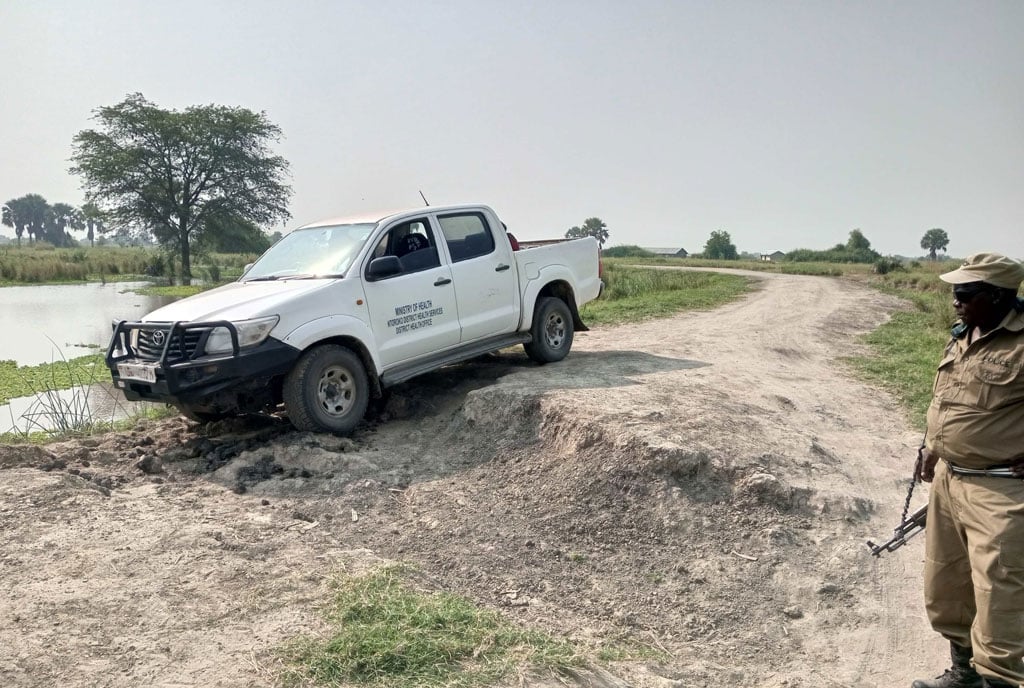
A section of the road which connect Rwenbisengo and Kanara sub-counties in Ntoroko District, which is in a sorry state. The district’s budget has reduced from Shs21 billion in the 2023/24 financial year to Shs19.6 billion in the current budget, which leaders say will affect service delivery. PHOTO/ALEX ASHABA
The recently released preliminary results of the 2024 National Population and Housing Census show a significant population increase in Tooro Sub-region, from 2,573,910 in 2014 to 3,378,840 in 2024. This represents an addition of 804,930 people or a 31 percent growth rate.
The sub-region now has an annual growth rate of 2.8 percent and is ranked seventh out of 14 sub-regions in the country in terms of population growth, according to the report.
Leaders in the sub-region say investment in infrastructure, healthcare, education, and other critical services will be crucial in ensuring that the growing population thrives.
This demographic shift presents opportunities and challenges for service delivery in the sub-region. Tooro Sub-region comprises eight districts (Kasese, Kitagwenda, Kamwenge, Ntoroko, Bundibugyo, Kyegegwa, Kabarole, Buyangabu, Kyenjojo, Ntoroko) and a city (Fort Portal).
Kyegegwa District had a 78 percent increase in population, rising from 281,637 in 2014 to 501,535 in 2024. This represents an addition of 219,898 people over the decade. Ntoroko District registered a 71 percent increase in population, rising from 67,005 in 2014 to 114,859 in 2024.
Kasese registered a population growth of 22 percent, from 694,987 to 847,027; Bundibugyo’s growth rate stood at 18 percent, from 224,387 to 264,615; Kabarole had a 17 percent growth, from 196,749 to 230,603; while Fort Portal with 33 percent saw its population rise from 102,240 to 135,702; and Buyangabu had 28 percent growth, from 170,247 to 218,723.
Others are Kyenjojo with 29 percent growth, from 422,204 to 543,757; Kamwenge had a 24 percent growth rate, from 270,668 to 336,738; and Kitagwenda registered 29 percent growth, from 143,786 to 185,281.
Leaders and stakeholders say a high population poses challenges that require immediate and strategic responses from both local and national governments.
Mr James Atuhiirwe, an economist, says the population surge necessitates a commensurate expansion in service delivery to meet the growing population’s needs in key areas such as healthcare, roads, education, and employment.
“When the population increases, service delivery needs to match the population growth. Planners need to consider these numbers across different districts. For example, Ntoroko District has almost doubled in population, but has its budget increased? We need more health facilities, better roads, and other essential services,” Mr Atuhiirwe says.
All the districts in Tooro Sub-region rely mainly on Fort Portal Regional Referral Hospital for health services.
Dr Alex Adaku, the director of Fort Portal Regional Referral Hospital, says the facility has been relying on estimates to plan for the people in the entire region since 2014. He, however, says the new numbers will help them plan better.
Dr Adaku says to avoid putting excessive pressure on the hospital, much focus must be placed on disease prevention at the community level, allowing the facility to handle referred cases more effectively and minimising the expenditure on minor cases.
“The 3.4 million people in the Tooro Sub-region represent an impact on the health sector. The most important strategy is to focus on prevention so that fewer people come to our facility for clinical care. Health problems should be prevented in the community, and only those who need admission should come to the hospital,” Dr Adaku says.
He says he is optimistic that the new population numbers will lead to an increase in the resource allocation to the facility by the government, adding that the current budget is insufficient to handle existing problems.
“We need to think of revising the budget. We have not yet achieved a 15 percent budget allocation to the health sector, which affects our interventions,” Dr Adaku says.
Mr Robert Biita, the Kabarole District planner, says the population increase will impact service delivery, especially in health, education, roads, and water supply in the district.
“What we know now is that the population of our district has increased, and we need to adjust our planning. But to conclude, we first need to understand how many children will need immunisation and how many are school-going so that we can plan for more desks and classrooms,” Mr Biita says.
The 2024/2025 financial year budget for Kabarole District is Shs29 billion, a decrease from the Shs35 billion budget of the 2023/2024 financial year.
The Fort Portal City Speaker, Mr Albert Ahebwa, says he is concerned about the timing of the census exercise, which coincided with the closing of the budgeting process for most local governments.
“We didn’t get a chance to plan for new numbers because we didn’t know them. For the new financial year coming, we have to consider the new numbers since the budget cycle is starting soon,” he says.
Mr Ahebwa says they need to assess the district’s budget to align it with the growing population for effective service delivery.
“A higher population puts pressure on services such as healthcare, education, and infrastructure. The budget needs to cater to the expanding population to ensure adequate services and infrastructure are in place to support the community,” he says.
He adds that the city is likely to face a significant challenge in ensuring all residents receive adequate services because the budget was based on the old population numbers from the 2014 census.
In Ntoroko District, the 2024/25 budget stands at Shs19.6 billion down from Shs21 billion in the 2023/24 financial year.
The district concluded the 2023/2024 financial year with a staffing shortage, particularly in the health department’s primary health care (PHC) category. This shortage involves 26 critical positions, needing a total of 94 new recruits.
The district was unable to utilise Shs2.7 billion under PHC to recruit staff despite their request for a waiver from the Ministry of Public Service.
The district chairperson, Mr William Kasoro, says the government has been planning for the district based on the 2014 population of 67,005 people.
“As a district, it is very hard to align the new population figures with our budget. We have been grappling with implementing a budget based on estimates. Now, with a 71 percent population increase, can we have a budget increase by the same percentage to meet the required demands for services?” he says.
Mr Kasoro suggests that planners at the national level need to revise the budget planning figures to reflect the district’s new population for better services.
He says in the meantime, they will need partners to help serve the people.
Mr Kasoro adds that the district will need to construct more classrooms, recruit additional teachers, and provide sufficient educational materials to ensure quality education for all children.
“We are already seeing pressure with the meager resources we have. Many children born in the last 10 years are now reaching school age, but our existing infrastructures are not enough,” he says.
The district also needs emergency funding of about Shs3 billion to address flood-related issues that have affected more than three schools. Some of the schools need renovation while others require reconstruction.
The district is also dealing with approximately 9,000 internally displaced persons from the 2019 Lake Albert floods, who need relocation to safer areas.
The Kyenjojo District Chairperson, Mr Richard Rubaihayo, says the population increase will put additional pressure on wetlands, as soil productivity is decreasing, which will exacerbate the effects of climate change.
“Our budget projection has been for 550,000 people, but the biggest challenge ahead lies in environmental and social services. We need to tarmac roads such as Kyenjojo-Kyakatwire, as traffic has increased compared to the previous year. Additionally, poverty levels are likely to rise,” he says.
Mr Rubaihayo says the district’s budget increased to Shs52 billion from Shs48 billion in the 2023/2024 financial year, though it remains insufficient.
Environmentalists have warned that with increasing population numbers, there will be more pressure on land for settlement. They stressed the need for the government to allocate more funds to mitigate climate change.
Kasese, Bunyangabu, Kabarole, Ntoroko, and Bundibugyo have experienced the effects of climate change over the years, including floods and mudslides that have killed dozens of people, displaced others, and destroyed property.
“This time, we need to be serious about the increased population. I expect people to encroach on wetlands and riverbanks, and we will see many developments coming up at the expense of the environment. My appeal to the government is to plan better for this growing population,” Mr Alex Bwambale, an environmentalist from Kasese, says.
What they say
Mr James Atuhiirwe, an economist: When the population increases, service delivery needs to match the population growth. Planners need to consider these numbers across different districts. For example, Ntoroko District has almost doubled in population, but has its budget increased? We need more health facilities, better roads, and other essential services.
Mr Robert Biita, the Kabarole District planner: What we know now is that the population of our district has increased, and we need to adjust our planning. But to conclude, we first need to understand how many children will need immunisation and how many are school-going so that we can plan for more desks and classrooms.
Mr Alex Bwambale, an environmentalist: This time, we need to be serious about the increased population. I expect people to encroach on wetlands and riverbanks, and we will see many developments coming up at the expense of the environment. My appeal to the government is to plan better for this growing population.




